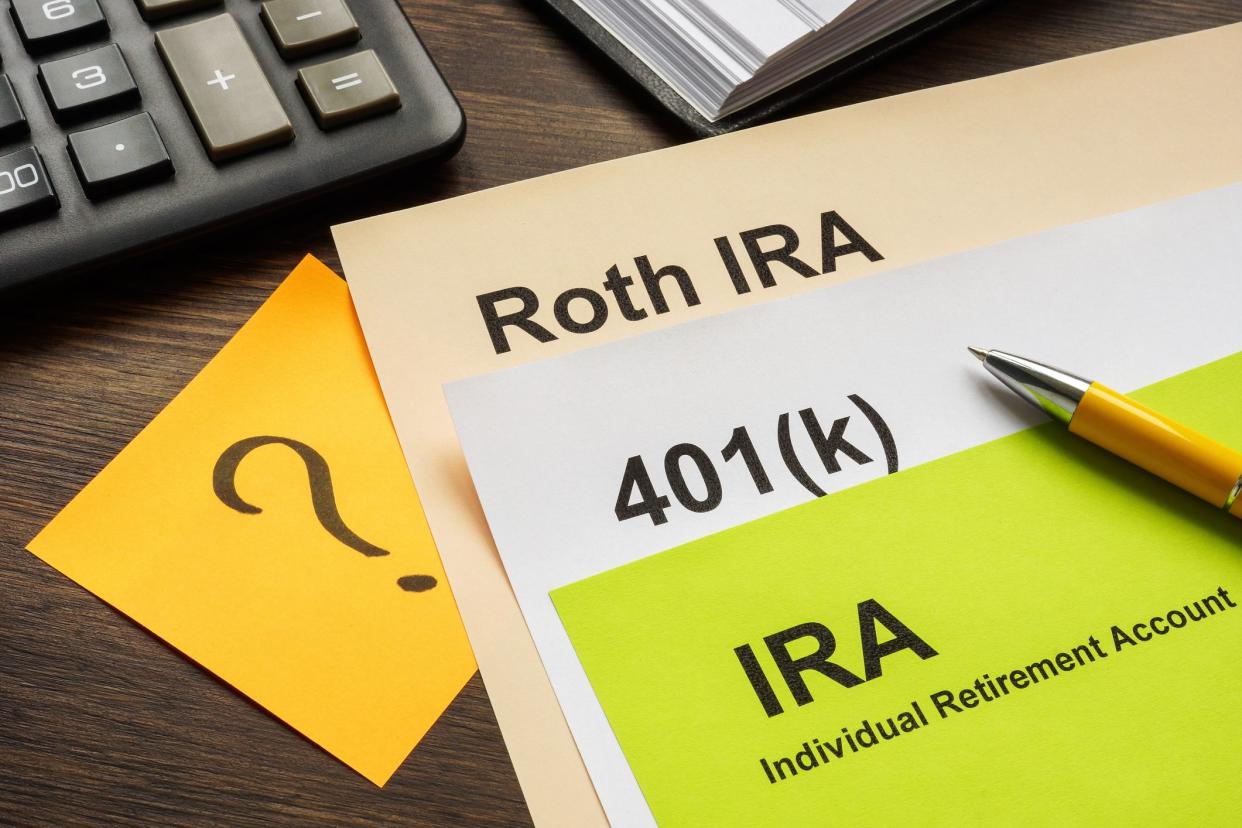shironosov/istockphoto
How Should a Novice Investor Get Started?
Hi again! As you know, on the Money Girl podcast I answer your burning money questions! Today’s topic comes from Mary, who says:
“I know that I need to invest for the future but really don’t know where to start. My job doesn’t offer a retirement plan. Can you give tips for how a complete novice can start investing without taking a lot of risk?”
Mary, I appreciate your question because investing can initially seem complicated and risky. But I promise it’s easy to start slowly and without taking too much risk. This post will review the steps anyone can take to begin investing based on your financial situation and goals.


Jelena Danilovic/Istockphoto
What’s the difference between investing and saving?
Many novice investors need clarification about the difference between investing and saving. So, before you do anything with your money, master this concept.
Saving is putting money into a safe account, such as FDIC-insured savings, so you preserve it. That’s critical for short-term goals, like building an emergency fund or buying a car within a year or two. You want a cash reserve to be there when you need it for planned and unexpected hardships, such as a job loss or medical bill.
Investing is for long-term goals you want to achieve in at least three or more years.
They might include buying a home, paying for a child’s college, and retirement. You put money into assets or financial instruments, such as real estate or index funds, expecting future growth. Generally, investing isn’t appropriate for short-term goals because market values fluctuate within short periods.
Investing requires some risk, but without it, you aren’t likely to earn enough growth to beat inflation and achieve significant financial goals like retiring. A good rule of thumb is to invest a minimum of 10% to 15% of your gross income annually.
While it’s wise to begin investing as soon as possible, ensure you have enough savings first. A good target is three to six months’ worth of your living expenses (housing, food, utilities, and debt payments). For example, if your living expenses total $4,000 each month, make a goal to keep $12,000 in savings.
If you can only set aside one month of living expenses in savings, that’s better than nothing. You’re ready to begin investing once you have a comfortable cash reserve to keep you safe. You can also contribute to a savings and investing account simultaneously when ready.


PeopleImages/istockphoto
6 tips for becoming a wise investor
Use the following six tips for reducing risk and earning more as an investor.
-
Purchase a diversified investment portfolio.
Buying and selling individual securities or stocks isn’t wise for the average investor. That’s because no one can predict whether their values will go up or down. A better strategy is investing in one or more diversified funds, which bundle investments, making them convenient to purchase.
Investment funds are diversified because they’re made up of hundreds or thousands of underlying securities, such as stocks, bonds, currencies, and real estate. Diversifying allows you to earn higher average returns while reducing risk. If some securities within a fund lose value, some increase, minimizing potential losses.
Since the 1920s, the historical average return of the stock market has been approximately 10%. So, if you have decades to go before you retire, consider investing a large percentage of your portfolio in stock funds, such as index funds.
Stock prices fluctuate in the short term but will likely increase over the long term, giving you a great return. For instance, even if you only earned an average 7% return on your investments, you’d have a nest egg worth just over $1 million after investing $400 a month for 40 years.


KucherAV/istockphoto
2. Understand investment funds.
Every novice investor should be familiar with different types and categories of funds. Here are a few you’ll likely see on a typical investing account menu.
Mutual funds are a collection of assets managed by a fund professional. Buying and selling shares in a mutual fund are restricted to the end of the trading day when the fund’s net asset value gets calculated.
Exchange-traded funds (ETFs) are similar to mutual funds in that they are baskets of assets. However, they trade like individual stocks, meaning you can buy or sell ETF shares throughout the day and should expect price fluctuations.
Index funds are mutual funds that usually come with low fees and may be made up of thousands of underlying investments. Index funds aim to match or outperform a specific index, such as the Standard & Poor’s 500 Index or Dow Jones Industrial Average.
Target date funds are mutual funds that automatically reset the mix of assets in their portfolio according to your set time frame, such as when you plan to retire.
Be aware that funds come with different fees, known as an expense ratio. For example, a 1% expense ratio means that 1% of the fund’s assets is used to pay yearly expenses, such as management and advertising. Generally, choosing low-cost funds, such as ETFs and index funds, is best to avoid unnecessary costs that diminish your returns.


designer491/istockphoto
3. Purchase funds inside a workplace retirement account.
When you purchase investments inside a workplace retirement account, such as a 401(k) or 403(b), you accumulate wealth for retirement and get terrific money-saving tax benefits. However, if you’re like Mary and don’t have one, you have access to other terrific tax-advantaged options I’ll cover.
Most employers offer traditional and Roth accounts, which have different rules and advantages. Traditional retirement accounts allow you to defer tax until you make withdrawals in the future. Roth retirement accounts require you to pay tax on your contributions but allow tax-free withdrawals in retirement. Note that you can choose either type no matter how much you earn.
Workplace retirement accounts are even more valuable if your employer pays matching funds. For example, your company may match your contributions to a limit, such as 3% of your salary. If you earn $60,000 and contribute $1,800 (3% of your salary) per year, your employer would add $1,800 annually or $150 per month to your retirement account. Pretty sweet!
But even if you don’t get employer matching, it’s wise to max out your workplace retirement account every year. For 2024, you can contribute up to $23,000 or $30,500 if you’re over 50.
Your workplace retirement plan contributions get automatically deducted from your pay, making investing regularly easy. If you leave your job, you can transfer your vested balance into an IRA by doing a tax-free rollover.


designer491 / istockphoto
4. Purchase funds inside an individual retirement account (IRA).
But what if your employer doesn’t offer a retirement plan? Or you’re self-employed or a stay-at-home spouse? Yes, you can invest using a retirement account, too.
Everyone with earned income (even minors) qualifies for a traditional IRA. You make pre-tax contributions and defer taxes until you make withdrawals in retirement. There are no income limits to qualify. If you’re married and file taxes jointly but have no income, you can invest based on your spouse’s income.
For 2024, you can contribute up to $7,000 or $8,000 if you’re over age 50 to a traditional IRA. The annual contribution limit is the same for a Roth IRA; however, a Roth IRA has a qualifying income limit. For 2024, you must earn less than $161,000 as an individual taxpayer or $240,000 as a married couple filing jointly to make Roth IRA contributions.
With a Roth IRA, you pay tax on your contributions but can make tax-free withdrawals in retirement. In general, using a Roth makes sense if you believe your taxes in retirement will be higher than they are now.
Mary didn’t mention her income, but if she earns less than the Roth IRA income limits I mentioned, that’s where I’d recommend she invest. It’s easy to open an account and set up regular contributions using a robo-investing platform like Betterment.
A robo-advisor manages your portfolio automatically based on features you select, such as your stated risk tolerance, age, and goals. It’s an algorithm recommending a diversified portfolio, typically a mix of five to ten exchange-traded funds (ETFs). Because trading is automated, robo-advising platforms usually charge low fees and are excellent choices for new or experienced investors.


PeopleImages/istockphoto
5. Ignore what you can’t control as an investor.
Wise investors stay focused on building wealth over the long term using a buy-and-hold strategy. What happens in the financial markets daily only matters if you must liquidate your investments during the same period.
In other words, you should ignore media hype and never make rash decisions, such as selling your investments when their value drops. Your goal should be to get investment growth over decades, not month-to-month or even year-to-year.


Ridofranz/istockphoto
6. Get professional investment advice.
Mary, if you need help choosing investments, seek advice from your investment
platform. Even robo-investing companies, like Betterment, have human advisors to guide you through opening your account and selecting suitable investments based on your goals.
This article originally appeared on Quickanddirtytips.com and was syndicated by MediaFeed.org.


Jacob Wackerhausen/istockphoto




